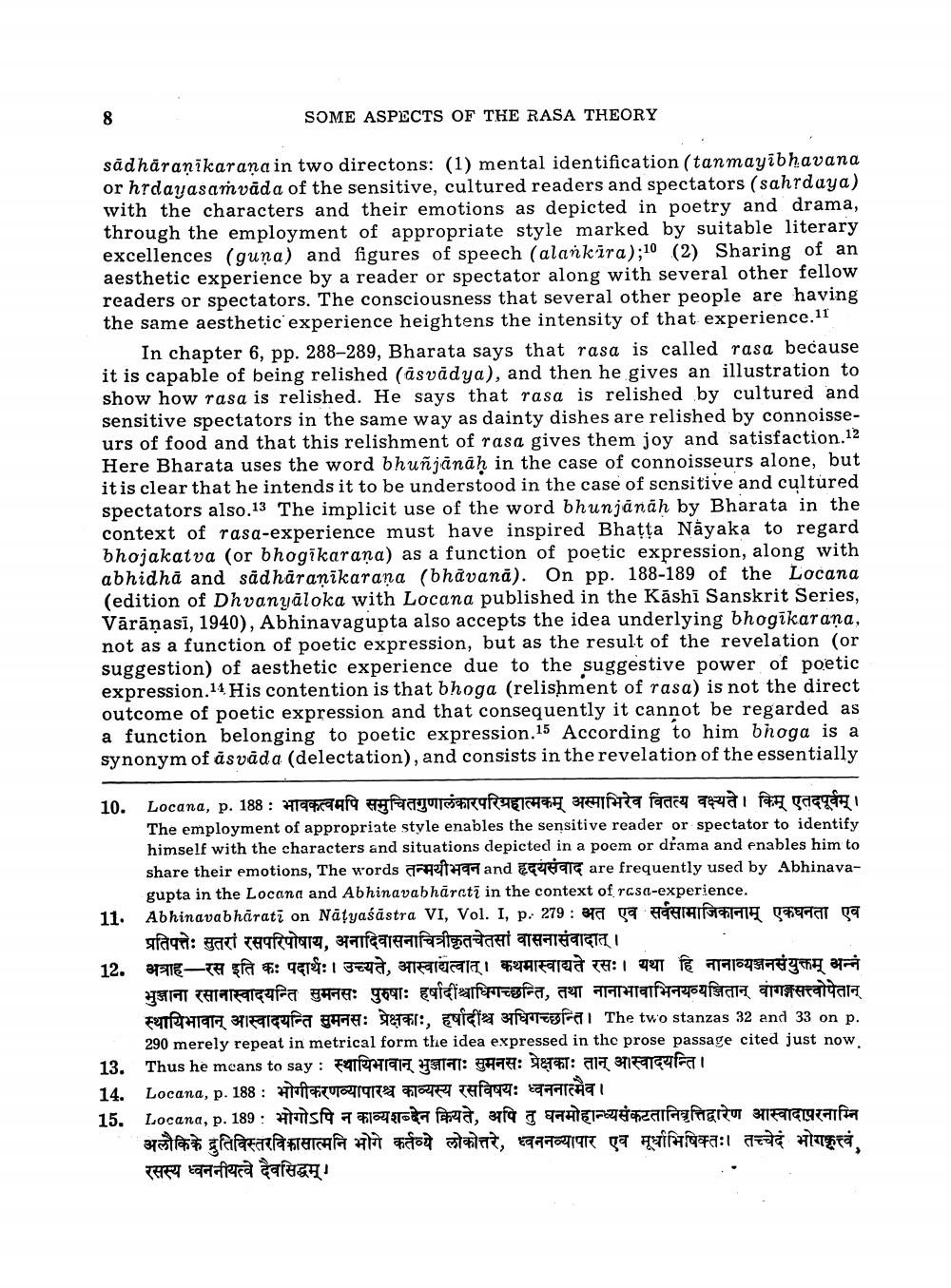________________
SOME ASPECTS OF THE RASA THEORY
sādharanikarana in two directons: (1) mental identification (tanmayibhavana or hrdayasamvada of the sensitive, cultured readers and spectators (sahrdaya) with the characters and their emotions as depicted in poetry and drama, through the employment of appropriate style marked by suitable literary excellences (guna) and figures of speech (alankira); 10 (2) Sharing of an aesthetic experience by a reader or spectator along with several other fellow readers or spectators. The consciousness that several other people are having the same aesthetic experience heightens the intensity of that experience.11
In chapter 6, pp. 288-289, Bharata says that rasa is called rasa because it is capable of being relished (åsvädya), and then he gives an illustration to show how rasa is relished. He says that rasa is relished by cultured and sensitive spectators in the same way as dainty dishes are relished by connoisseurs of food and that this relishment of rasa gives them joy and satisfaction.12 Here Bharata uses the word bhuñjānāh in the case of connoisseurs alone, but it is clear that he intends it to be understood in the case of sensitive and cultured spectators also.13 The implicit use of the word bhunjānah by Bharata in the context of rasa-experience must have inspired Bhatta Nayaka to regard bhojakatva (or bhogikarana) as a function of poetic expression, along with abhidhā and sādharanikarana (bhāvanā). On pp. 188-189 of the Locana (edition of Dhvanyaloka with Locana published in the Kashi Sanskrit Series, Vārāṇasi, 1940), Abhinavagupta also accepts the idea underlying bhogikarana, not as a function of poetic expression, but as the result of the revelation (or suggestion) of aesthetic experience due to the suggestive power of poetic expression. 14 His contention is that bhoga (relishment of rasa) is not the direct outcome of poetic expression and that consequently it cannot be regarded as a function belonging to poetic expression. 15 According to him bnoga is a synonym of ăsvāda (delectation), and consists in the revelation of the essentially
10. Locana, p. 188: HT49afa fragor of EICH E a faca ayat PEF Sagan
The employment of appropriate style enables the sensitive reader or spectator to identify himself with the characters and situations depicted in a poem or drama and enables him to share their emotions, The words
and acai are frequently used by Abhinavagupta in the Locana and Abhinavabhārstī in the context of rosa-experience. Abhinavabhārati on Nățyaśāstra VI, Vol. I, p. 279: sta ga HTHAF 9 ga प्रतिपत्तेः सुतरां रसपरिपोषाय, अनादिवासनाचित्रीकृतचेतसां वासनासंवादात्। अत्राह-रस इति कः पदार्थः। उच्यते, आस्वाद्यत्वात्। कथमास्वाद्यते रसः। यथा हि नानाव्यञ्जनसंयुक्तम् अन्नं भुजाना रसानास्वादयन्ति सुमनसः पुरुषाः हर्षादींश्चाधिगच्छन्ति, तथा नानाभावाभिनयव्यजितान् वागङ्गसत्त्वोपेतान् FATTATTI TIFFa 5498: FI:, ita fereaf-a1 The two stanzas 32 and 33 on p.
290 merely repeat in metrical form the idea expressed in the prose passage cited just now 13. Thus he means to say : FAT917 YETAT: yhaa: 987 : 017 311Facy fra 14. Locana, p. 188: H RUTI9R29 Tappi Tafaa chai 15. Locana, p. 189 : Sf 7 164 Tota, fa 7 THEzalago 311Figarria
अलौकिके द्रुतिविस्तरविकासात्मनि भोगे कर्तव्ये लोकोत्तरे, ध्वननव्यापार एव मूर्धाभिषिक्तः। तच्चेदं भोगकृत्त्वं रसस्य ध्वननीयत्वे देवसिद्धम्।




